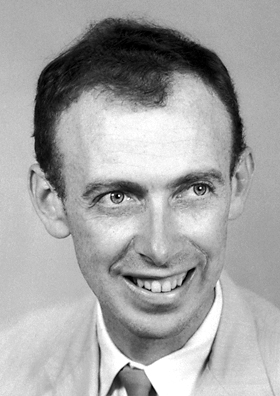Watson: Difference between revisions
No edit summary |
No edit summary |
||
| (6 intermediate revisions by 3 users not shown) | |||
| Line 1: | Line 1: | ||
[[Image:Watson postcard.jpg| | [[Image:Watson postcard.jpg|right|James Dewey Watson]] James Dewey Watson was born in Chicago on April 6th 1928. Watson was most notably awarded the Nobel Prize in Physiology or Medicine 1962<ref>http://www.nobelprize.org/nobel_prizes/medicine/laureates/1962/watson-facts.html</ref> alongside [[Francis Crick|Francis Harry Compton Crick]] and [[Maurice Wilkins|Maurice Hugh Frederick Wilkins]]. Watson and Crick discovered the structure of DNA via x-ray diffraction<ref>Rastogi, S. C. (2003). Cell and Molecular Biology. New Age International (P) Ltd, Publishers.fckLRPage 90</ref>, their model of a double helical configuration showed how a [[DNA|DNA]] molecule could duplicate itself<ref>http://www.biography.com/people/james-d-watson-9525139#early-years</ref>. | ||
=== Career === | |||
As a young child, Watson was very inquisitive and enjoyed bird watching as a hobby. When he was 15 years of age Watson entered the University of Chicago under the gifted youngster programme. Watson studied biology and zoology, which interested him deeply, and decided to go to graduate school to become the curator of orthinology at the Museum of Natural History. | |||
After reading 'What is life? The physical aspect of the living cell,' by Erin Schrodinger, he decided to do a PhD with Salvador Luria at Indiana University<ref>http://www.dnaftb.org/19/bio.html</ref>. | |||
=== References === | |||
=== References === | |||
<references /> | <references /> | ||
Latest revision as of 21:16, 6 December 2018

James Dewey Watson was born in Chicago on April 6th 1928. Watson was most notably awarded the Nobel Prize in Physiology or Medicine 1962[1] alongside Francis Harry Compton Crick and Maurice Hugh Frederick Wilkins. Watson and Crick discovered the structure of DNA via x-ray diffraction[2], their model of a double helical configuration showed how a DNA molecule could duplicate itself[3].
Career
As a young child, Watson was very inquisitive and enjoyed bird watching as a hobby. When he was 15 years of age Watson entered the University of Chicago under the gifted youngster programme. Watson studied biology and zoology, which interested him deeply, and decided to go to graduate school to become the curator of orthinology at the Museum of Natural History.
After reading 'What is life? The physical aspect of the living cell,' by Erin Schrodinger, he decided to do a PhD with Salvador Luria at Indiana University[4].
References
- ↑ http://www.nobelprize.org/nobel_prizes/medicine/laureates/1962/watson-facts.html
- ↑ Rastogi, S. C. (2003). Cell and Molecular Biology. New Age International (P) Ltd, Publishers.fckLRPage 90
- ↑ http://www.biography.com/people/james-d-watson-9525139#early-years
- ↑ http://www.dnaftb.org/19/bio.html